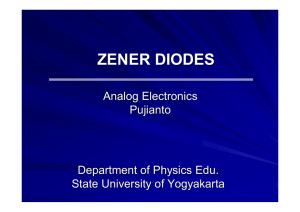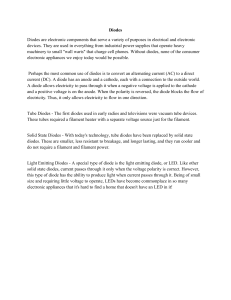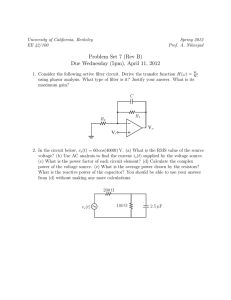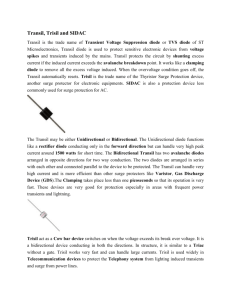Transient Voltage Suppression Diode Application Notes
advertisement
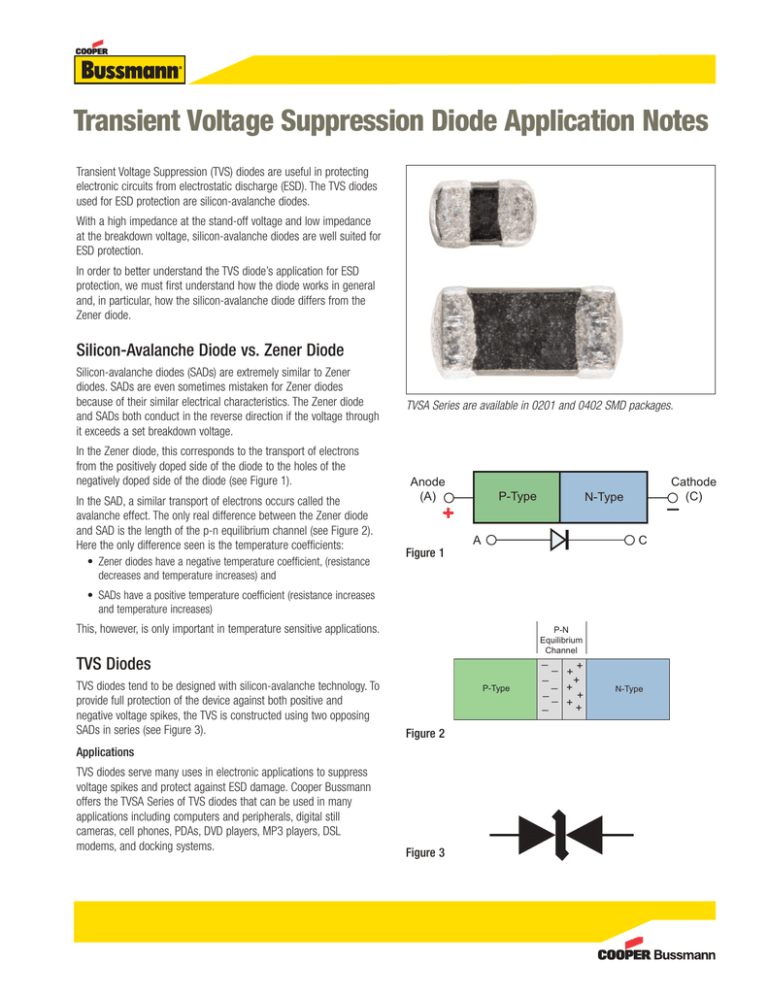
Transient Voltage Suppression Diode Application Notes Transient Voltage Suppression (TVS) diodes are useful in protecting electronic circuits from electrostatic discharge (ESD). The TVS diodes used for ESD protection are silicon-avalanche diodes. With a high impedance at the stand-off voltage and low impedance at the breakdown voltage, silicon-avalanche diodes are well suited for ESD protection. In order to better understand the TVS diode’s application for ESD protection, we must first understand how the diode works in general and, in particular, how the silicon-avalanche diode differs from the Zener diode. Silicon-Avalanche Diode vs. Zener Diode Silicon-avalanche diodes (SADs) are extremely similar to Zener diodes. SADs are even sometimes mistaken for Zener diodes because of their similar electrical characteristics. The Zener diode and SADs both conduct in the reverse direction if the voltage through it exceeds a set breakdown voltage. In the Zener diode, this corresponds to the transport of electrons from the positively doped side of the diode to the holes of the negatively doped side of the diode (see Figure 1). In the SAD, a similar transport of electrons occurs called the avalanche effect. The only real difference between the Zener diode and SAD is the length of the p-n equilibrium channel (see Figure 2). Here the only difference seen is the temperature coefficients: • Zener diodes have a negative temperature coefficient, (resistance decreases and temperature increases) and TVSA Series are available in 0201 and 0402 SMD packages. Anode (A) P-Type + Figure 1 Cathode (C) _ N-Type C A • SADs have a positive temperature coefficient (resistance increases and temperature increases) This, however, is only important in temperature sensitive applications. P-N Equilibrium Channel TVS Diodes TVS diodes tend to be designed with silicon-avalanche technology. To provide full protection of the device against both positive and negative voltage spikes, the TVS is constructed using two opposing SADs in series (see Figure 3). P-Type Figure 2 Applications TVS diodes serve many uses in electronic applications to suppress voltage spikes and protect against ESD damage. Cooper Bussmann offers the TVSA Series of TVS diodes that can be used in many applications including computers and peripherals, digital still cameras, cell phones, PDAs, DVD players, MP3 players, DSL modems, and docking systems. Figure 3 _ + _ + _ _ ++ _ + _ + _ + N-Type Features Design Considerations The Cooper Bussmann TVSA Series is RoHS compliant and lead free for global applications with excellent ESD protection as tested by IEC 61000-4-2 level 4 test. The location in the circuit for the TVSA Series has to be carefully determined. For better performance, the device should be placed as close to the signal input as possible and ahead of any other component. Due to the high current associated with an ESD event, it is recommended to use a “0-stub” pad design (pad directly on the signal/data line and second pad directly on common ground). Cooper Bussmann offers some of the only SMD, low profile TVS diodes available in 0201 and 0402 sizes. The TVSA Series features very low clamping voltages for increased device protection from overvoltage events. The TVSA Series also provides comparatively low capacitance compared to many other diode-based solutions and the low leakage current minimizes power consumption. TVSA Specifications* Catalog Symbols: TVSA02V05C004 (0201 size) TVSA04V05C006 (0402 size) To properly specify a Cooper Bussmann TVSA Series diode, a few things need to be taken into consideration. First is knowing the circuit’s data speed and/or the maximum tolerable circuit capacitance. This is extremely important when deciding if it is practical to use a TVS diode solution. For example, in protecting a USB2.0 port, the TVSA capacitances of 4-6pF are not practical, as this high capacitance may distort the data signal. Technology: • Transient voltage suppression via solid-state silicon-avalanche diode technology Electrical Characteristics: • Reverse Stand-off Voltage: 5Vdc • Reverse Breakdown Voltage: 10Vdc • Capacitance: 4pF (0201) 6pF (0402) Another important consideration is knowing the voltage the circuit can withstand without incurring damage. The TVSA clamping voltage rating should be below this voltage. The clamping voltage is the peak voltage across the TVS diode at the peak current of an 8/20μs waveform with 1A pulse current (see Figure 4). The final consideration when specifying a TVS diode is the circuit’s normal running voltage. It is beneficial to have the TVSA stand-off voltage (the maximum voltage where the leakage current does not exceed 10μA) above the normal operating current of the circuit. This ensures the low leakage current of the TVS diode. ESD Capability: • IEC61000-4-2 Direct Discharge: 8kV • IEC61000-4-2 Air Discharge: 15kV * For more details, see Data Sheet 4072 online at www.cooperbussmann.com/elx TVSA Series Dimensions - mm % Peak Pulse Current 20µs W C L L 0.60±0.05 1.00±0.15 W 0.30±0.05 0.50±0.10 H 0.30±0.05 0.50±0.10 50% 0% 8µs H Size 0201 0402 100% Figure 4 C 0.20±0.10 0.25±0.15 Order samples online - www.cooperbussmann.com © 2009 Cooper Bussmann St. Louis, MO 63178 636-394-2877 www.cooperbussmann.com Reorder # 4048 PDF Only
